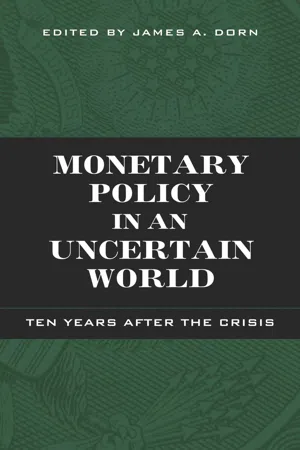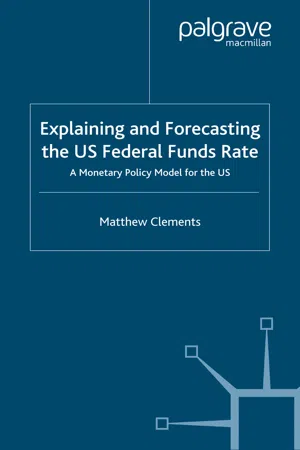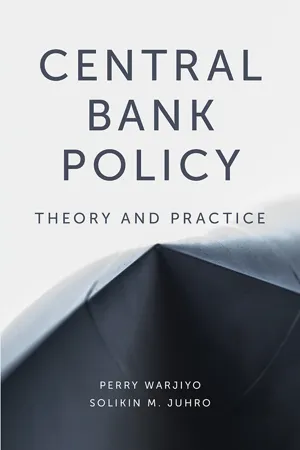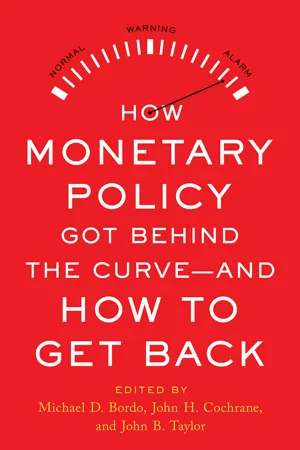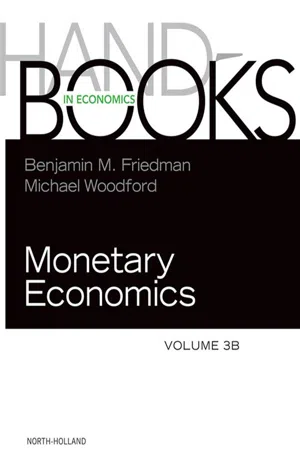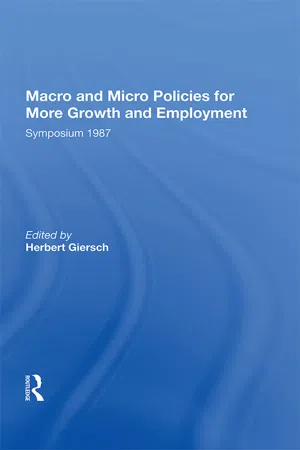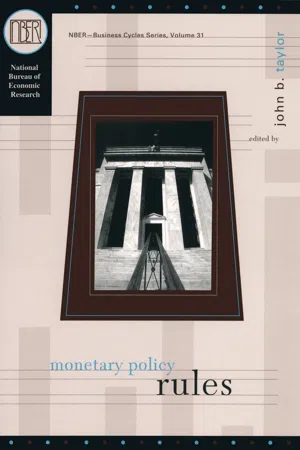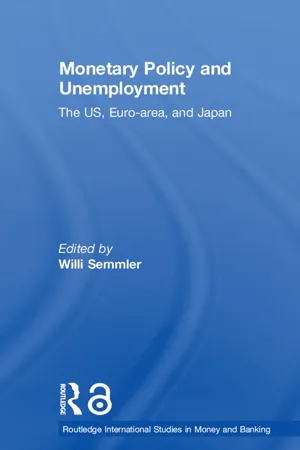Economics
Rule Based Monetary Policy
Rule-based monetary policy refers to a framework in which central banks follow predetermined guidelines or rules to make decisions about interest rates and money supply. This approach aims to provide transparency and predictability in monetary policy, reducing the potential for discretionary actions that could lead to economic instability. By adhering to specific rules, central banks seek to anchor inflation expectations and promote long-term economic stability.
Written by Perlego with AI-assistance
Related key terms
1 of 5
11 Key excerpts on "Rule Based Monetary Policy"
- eBook - ePub
Monetary Policy in an Uncertain World
Ten Years After the Crisis
- James A. Dorn(Author)
- 2018(Publication Date)
- Cato Institute(Publisher)
McCallum 2004 : 370].A monetary rule is a constraint on the monetary authority in line with the rule of law. In addition to reducing regime uncertainty and increasing predictability of money and prices, a credible rule reduces the concentration of power over monetary matters and expands economic freedom. As Milton Friedman notes, in reference to the Fed’s failure to maintain monetary stability during the Great Depression when the money supply contracted by nearly 30 percent, “much harm can be done by mistakes on the part of a few men when they wield vast power over the monetary system of a country” (Friedman 1962 : 50).When policymakers have to follow known rules that recognize the limits of monetary policy and the social value of maintaining sound money, markets will be better able to perform their incentive, information, and allocation functions. There will be less risk of government intervention (e.g., price controls, credit allocation, and the politicization of investment) under a rules-based monetary regime than a discretionary regime. Government power grows, and economic freedom declines, when money and markets are in disorder, as we learned from the Great Depression, the high inflation and ensuing price controls of the 1970s, and the Great Recession, which greatly increased the Fed’s monetary and regulatory powers.The Case for a Monetary ConstitutionMonetary authorities have an incentive to increase their discretionary powers, especially during a crisis. When the Federal Reserve started operating in 1914, its powers were narrowly limited. Today, the Fed’s balance sheet has reached $4.5 trillion and it engages in massive credit allocation and financial regulation. The 2008 financial crisis greatly expanded the Fed’s powers, and there is little incentive for Federal Reserve Board members to relinquish those powers. - eBook - ePub
Development Macroeconomics
Essays in Memory of Anita Ghatak
- Subrata Ghatak, Paul Levine(Authors)
- 2009(Publication Date)
- Taylor & Francis(Publisher)
Just because monetary policy rules can be written down as a mechanical-looking equation, this does not imply that central banks should follow them mechanically. To the contrary, most proposals for monetary policy rules suggest that the rules are best used as guidelines, or general policy frameworks. Discretion is needed to implement the policy rule.The Taylor rule (Taylor 1993) suggests a very specific policy for the central bank. It calls for the quarterly average US interest rate to rise by 1.5 times any increase in the four-quarter average inflation rate plus 0.5 times any increase in the output gap. Even so, the Taylor rule is a guideline for assessing interest rate decisions. Discretion is needed to assess monthly data on commodity prices, employment, industrial output and other variables, in order to estimate or predict the current quarterly inflation rate and the output gap.3 Inflation targeting
Having an inflation target is essential for good monetary policymaking in cases where a country decides on a flexible exchange rate regime. The inflation target places the nominal anchor on domestic prices. In this it contrasts with a fixed exchange rate regime, a currency board, or dollarization. The increased focus on the inflation target in transition economies is a welcome development. By the target rate of inflation we mean the value level of inflation that one would like to be the one that the actual inflation rate fluctuates around. The table opposite provides an impression of the inflation targets of some countries that operate an inflation targeting regime.Having a target for the inflation rate is not enough. There are many different policies and instruments that will achieve an inflation target over the long run. Some policies will involve much larger fluctuations in other variables of concern to policymakers, such as the exchange rate or the real output. Thus, choosing an inflation target still leaves open most of the important questions about monetary policy decisions. That is where a monetary policy rule comes in. It provides the details about how the inflation target is to be met. - eBook - ePub
Rules for International Monetary Stability
Past, Present, and Future
- Michael D. Bordo, John B. Taylor, Michael D. Bordo, John B. Taylor(Authors)
- 2017(Publication Date)
- Hoover Institution Press(Publisher)
Chapter Six Rules-Based International Monetary Reform John B. Taylor, Richard Clarida, and George P. Shultz PART 1 An International Monetary System Built on Policy Rules and StrategiesJohn B. Taylor1For nearly two decades in the 1980s and 1990s, economic performance and stability improved in major parts of the world as monetary policy tended to be more focused and rules based. During much of the past decade, monetary policy has deviated from a rules-based approach in much of the world, and economic performance and stability has deteriorated, remaining poor today. As Paul Volcker (2014) has put it, “the absence of an official, rules-based, cooperatively managed monetary system has not been a great success.”In these remarks I discuss a new approach to international monetary policy. The proposed reform is based on years of experience and economic research which suggest that a rules-based reform in each country will deliver a rules-based international monetary system that “can better reconcile reasonably free and open markets with independent national policies [and] stability,” the sensible goal called for by Volcker (2014).I start with a review of the economic principles that indicate that such a rules-based policy will lead to good global economic performance. I then provide evidence—consistent with those principles—that shows that adhering to more rules-based policy has been associated with good performance while deviating from rules-based policy has been associated with poor economic performance. Building on this experience and the principles, I then describe the reform proposal and its implementation.The international monetary system: A rules-space or strategy-space approachEconomic research going back to the 1980s showed that simple rules-based monetary policy would result in good global economic performance (Carlozzi and Taylor 1985; Taylor 1985). In this research, the monetary policy of each central bank was viewed as a rule or strategy for the instruments of policy, and questions of international coordination or cooperation were addressed in “rules-space” or “strategy-space” rather than in terms of the setting for the policy instruments. If each central bank adopted a rules-based monetary policy that was optimal for its own country’s price and output stability, it would contribute to global stability. Moreover, there would be little additional gain from the central banks also jointly optimizing their policy rules or strategies. In other words, the research showed that the Nash equilibrium—where each country chose its monetary strategy taking as given other countries’ strategies—is nearly optimal, or nearly an internationally cooperative equilibrium. - eBook - ePub
Policy Stability and Economic Growth
Lessons from the Great Recession
- John B. Taylor(Author)
- 2016(Publication Date)
- London Publishing Partnership(Publisher)
To sum up, policymakers internationally have heeded, and have been right to heed, the core lesson of Taylor’s work: policy should be set systematically. This has been achieved by ongoing institutional evolution in regimes of constrained policy discretion, balancing the needs of credibility and flexibility. At the same time, if recent history is any guide, these policy frameworks will need to continue to evolve in response to events and experience – good and bad – if they are to achieve an appropriate balance between credibility and flexibility. That is particularly true of micro- and macro-prudential regimes, which, in institutional terms, remain in their infancy.Monetary policy rules in practiceTaylor’s famous 1993 paper, which introduced the Taylor rule, contained an important proviso: ‘simple, algebraic formulations of such rules cannot and should not be mechanically followed by policymakers’ (Taylor 1993). Two decades on, how are monetary policy rules being used in practice, and what have we learnt?Three big virtuesEven simple rules have been found to be very useful in the policy formulation process. Taylor rules are routinely examined by policymakers in central banks the world over. They feature prominently in central bankers’ speeches and frequently form the backbone of external commentary on monetary policy. There are three big virtues possessed by Taylor rules that might help explain their popularity.Firstly, Taylor rules capture the essence of modern macroeconomics. Monetary policy responds to deviations of inflation from target and output from its potential. These two objectives appear in the standard policymaker loss function in the academic literature. They also appear in the statutory mandates assigned to most central banks. Under certain conditions, those objectives can be shown to be consistent with maximising the expected utility of households (Woodford 1999).Taylor rules also embody the notion that, at times, policymakers may face a trade-off between these objectives. This trade-off can be represented by the Taylor curve – the set of output and inflation variability pairs possible under different monetary policy reaction functions (Taylor 1979). Situations in which policy can simultaneously keep inflation at target and output at potential – the so-called divine coincidence – are relatively rare. By imposing relative weights on inflation and the output gap, the Taylor rule offers a simple way of making choices from this menu. - eBook - PDF
Explaining and Forecasting the US Federal Funds Rate
A Monetary Policy Model for the US
- M. Clements(Author)
- 2003(Publication Date)
- Palgrave Macmillan(Publisher)
Although a discretionary policy approach offers the Fed greater flexibility in dealing with unex- pected shocks to the economy, it also allows far greater room for policy errors. Today, the Fed can be assumed to use a combination of discretion and the policy rules approach. The concept of an inflation target is closely linked with monetary policy rules. However, it remains something of an irony that although the Fed is associated with using policy rules, it still does not have an explicit inflation objective, even though the use of Taylor-type rules 21 MONETARY POLICY MODELS Figure 1.6 Taylor rule using annualized GDP data 1980–2002 using quarterly data requires the adoption of an inflation target. Consequently, Fed watch- ers have to infer this target from Fed statements and behaviour. Conversely, other central banks such as the European Central Bank (ECB) and Bank of England have explicit inflation targets but their policy decisions are perhaps considered to be more discretionary in nature. The adoption of an explicit inflation target helps reduce infla- tion expectations (ideally to the same level as the target rate itself), and can greatly enhance the credibility of a central bank if it establishes a record of consistently meeting the target. As such, it remains something of a dichotomy that the Fed has shown little willingness to adopt a target. Needless to say, when Fed decision making becomes more discre- tionary, monetary policy rules perform less well in describing movements in the FFR. However even Taylor himself did not advocate the exclusive adop- tion of a policy rules approach and recognized the importance of discretion in the decision-making process. Otherwise, the FOMC would be redundant and monetary policy could just as effectively be set by computer. It appears the Fed attaches great importance to the ability to disre- gard policy rules, and monetary policy rules of the Taylor-type variety are also highly dependent on the measure of inflation used. - eBook - ePub
Central Bank Policy
Theory and Practice
- Perry Warjiyo, Solikin M. Juhro(Authors)
- 2019(Publication Date)
- Emerald Publishing Limited(Publisher)
Operationally, the role of monetary aggregates can also be seen in the context of applying monetary policy in situations that require the central bank to support financial system stability. Interestingly, McCallum (1994) found that central banks possibly apply a macro-oriented monetary policy rule together with the role as lender of last resort (LOLR) in the financial system. In this respect, McCallum proposed a procedure using both interest-based rules and monetary based rules simultaneously in the case of the United States. Technically, the system consisted of: (1) a policy rule for the FFR designed to achieve the monetary base target; and (2) a policy rule that highlights the response of monetary growth to changes in the FFR. From the observations, McCallum concluded that the procedures explored could accommodate the macroeconomic goals together with the central bank acting as LOLR during the periods from 1974 to 1979 (September) and 1988 to 1991.7.4. Monetary Operations in Indonesia
7.4.1. Quantity-based Approach
Monetary policy implementation prior to the crisis referred to Act No. 13 of 1968 concerning the Central Bank, which stipulated the final targets (plural) of monetary policy at BI. In addition to low and stable inflation, BI was also mandated to achieve robust economic growth, low unemployment and a zero balance of payments (BOP). Operationally, however, BI relies heavily on base money (M0) as the operational target, with the nominal exchange rate target used as the policy anchor. In this case, the exchange rate is tightly controlled within a narrow band and depreciated at a relatively constant rate (managed exchange rate system). According to that monetary policy strategy framework, a controlled monetary base is expected to translate into controlled money supply (M1 and M2) and, therefore, economic activities (economic growth and prices). - Michael D. Bordo, John B. Taylor, John H. Cochrane, Michael D. Bordo, John B. Taylor, John H. Cochrane(Authors)
- 2023(Publication Date)
- Hoover Press(Publisher)
figure 4.1 . The other three rules considered by Bernanke, Kiley, and Roberts (2019b) are temporary price level targeting rules (TPLT) that are very similar to these seven rules but take into account the effective lower bound (ELB) of zero in the interest rate.Source: Bernanke, Kiley, and Roberts (2019b).FIGURE 4.1 .Policy Rules Studied by Bernanke, Kiley, and RobertsWhat explains this revival? One explanation is a revealed preference for such research on the part of monetary policy officials and others interested in monetary policy making. At the Chicago Fed conference, Cecchetti and Schoenholtz (2019) shared that they found, “The most frequently mentioned topic is the desirability of having a clear understanding of policy makers’ reaction function.” There were also statements by central bank leaders. Raghuram Rajan, former governor of the Reserve Bank of India, said, “What we need are monetary rules.” Mario Draghi, then president of the European Central Bank, said, “We would all clearly benefit from . . . improving communication over our reaction functions.” Jay Powell, chair of the Federal Reserve Board, said, “I find these rule prescriptions helpful.”Another explanation for the revival was the desire to figure out how to deal with the effective (or zero) lower bound on the interest rate. There was genuine concern about the lower bound in the case of a need for substantial easing. How else can one evaluate alternative proposals for “lower for longer” policy, such as the Reifschneider and Williams (2000) proposal, than with a rule? This is also a huge motivation behind the work by Lilley and Rogoff (2020).- eBook - ePub
- Benjamin M. Friedman, Michael Woodford(Authors)
- 2010(Publication Date)
- North Holland(Publisher)
Monetary policy rules. Chicago, IL: Chicago University Press; 1999:263–299.Levin AT, Wieland V, Williams JC. The performance of forecast-based monetary policy rules under model uncertainty. Am. Econ. Rev. 2003;93(3):622–645.Levin AT, Williams JC. Robust monetary policy with competing reference models. J. Monet. Econ. 2003;50:945–975.Lucas Jr. RE. Econometric policy evaluation: A critique. Carnegie Rochester Conference Series on Public Policy. 1976;1:19–46.Maisel SJ. Managing the dollar. New York: W.W. Norton; 1973.McCallum BT. Robustness properties of a rule for monetary policy. Carnegie-Rochester Conference Series on Public Policy. 1988;29:173–203.McCallum BT. Issues in the design of monetary policy rules. In: Taylor JB, Woodford M, eds. 1999:1483–1530. Handbook of Macroeconomics. Chapter 23.McCallum BT. Theoretical analysis regarding a zero lower bound on nominal interest rates. J. Money Credit Bank. 2000;32(4):870–904.McCallum BT. Should monetary policy respond strongly to output gaps? American Economic Review. Papers and Proceedings. 2001;91(2):258–262.McCallum BT, Nelson E. Targeting versus instrument rules for monetary policy. Federal Reserve Bank of St. Louis Review. 2005;87(5):597–611.McNees SK. Modeling the Fed: A forward-looking monetary policy reaction function. New England Economic Review November. 1986;3–8.Meyer L. A term at the Fed: An insider’s view. New York: HarperCollins; 2004.Meyer L. Dueling Taylor rules. 2009 Unpublished paper.Mishkin F. Housing and the monetary policy transmission mechanism. In: Federal Reserve Bank of Kansas City Jackson Hole Conference; 2007.Orphanides A. Monetary policy evaluation with noisy information. Board of Governors of the Federal Reserve System FEDS 1998–50. 1998.Orphanides A. Monetary policy rules based on real-time data. Am. Econ. Rev. 2001;91(4):964–985.Orphanides A. Monetary policy rules and the great inflation. American Economic Review, Papers and Proceedings. - Herbert Giersch(Author)
- 2019(Publication Date)
- Taylor & Francis(Publisher)
The reason for the rather loose relationship was simply that the standard errors in those vector autoregressions are fairly high. It was suggested that nominal interest rates should not be used as instruments because one does not know by simply looking at them whether they are high or low; such uncertainty would not exist for the judgement on the growth of the monetary base. 96 The difference between the proposed rule and a price level rule was stressed by several participants. In their opinion, a policy following McCallum's rule had the advantage that it would not react to an adverse supply shock with monetary tightness. This, however, would be required according to a price level rule, and the effect would be that the negative short-term real effects of a real shock on the economy would be exaggerated. In the McCallum rule, the supply shocks would be allowed to work through changes in the price level; in the medium run, how-ever, inflation would not be affected. What are the general characteristics of policy rules, and how can they be made effective? An important problem for policymakers is, of course, that at certain in - periods, policy options that have sub-optimal consequences in the long run (time inconsistency) may become optimal. The analogy of the flood , as described in Alan Blinder's paper, raises the problem of moral hazard: if the government were to intervene and pluck those people off the roofs who insited on building their houses in endangered areas, their behavior would indeed be encouraged. This is one of the crucial issues in the rules-versus-discretion debate and finds its parallel in, for example, stabilization policy when the central bank has to decide whether it should accommodate excessive wage increases.- eBook - PDF
- John B. Taylor(Author)
- 2007(Publication Date)
- University of Chicago Press(Publisher)
It is not appropriate, for example, when simulating a forward-looking model-as here-because it de- prives the system of a nominal anchor and thus leaves the price level indetermi- nate. So in our simulations we instead condition monetary policy (actual and in expectation) on the reaction function (1). This delivers a determinate price level. Simulations conducted in this way come close to mimicking current monetary policy practice in New Zealand (Reserve Bank of New Zealand 1997). There, the Reserve Bank of New Zealand's policy projections are based on an explicit policy reaction function, which is very similar to the baseline Some Limitations of the Simulations 29. This is also often the case with forecasts produced for the Federal Reserve Boards Green Book (see Reifschneider, Stockton, and Wilcox 1996). 173 Forward-Looking Rules for Monetary Policy rule (1). The Bank of England also recently began publishing inflation projec- tions based on market expectations of future interest rates, rather than constant interest rates. This means that differences between the forecast-based rule (I) and inflation targeting in practice may not be so sharp. 4.4 Stochastic Policy Analysis We now turn to consider the performance of the baseline rule ( I ) and com- pare it with alternative rules. This is done by embedding the various rules in the model outlined above and evaluating the resulting (unconditional) moments of output, inflation, and the policy instrument-the arguments typically thought to enter the central bank's loss function. Specifically, following Taylor (1993), we consider where each of the rules places the economy on the output-inflation variability frontier. 4.4.1 Lag Encompassing: The Optimal Degree of Policy Forward-Lookingness The most obvious rationale for a forward-looking monetary policy rule is that it can embody explicitly the lags in monetary transmission. - eBook - ePub
- Willi Semmler(Author)
- 2004(Publication Date)
- Routledge(Publisher)
4 It is therefore hard to draw a clear distinction between “rules” and “discretion” in this case. In the end, my analysis suggests that the unfavorable macroeconomic outcomes of the 1970s do not fundamentally reflect differences in the existing framework from Taylor’s rule-based framework. Rather, the analysis identifies misperceptions regarding the state of the economy in conjunction with an activist stabilization objective as the important factors leading to the inflationary experience of the 1970s.An overview of the Taylor rule
The Taylor rule originated in a collection of studies examining the comparative performance of alternative simple interest rate policy rules across a variety of different models (Bryant et al. 1993). A particularly promising rule in those studies prescribed that the Federal Reserve should set policy so that the deviation of the short-term nominal interest rate, R, from a baseline equilibrium value, R*, respond linearly to the deviation of inflation, π, from its desired target, π*, and to the output gap, y.Taylor (1993) proposed a particular parameterization of this rule that has attracted considerable attention. He set the sum of actual inflation and the equilibrium short-term real interest rate, r*, as a proxy for R*, and used the values r*=π*=2 and θ=1/2. (Throughout, the interest and inflation rates are stated in percent annual rates and the output gap in percent.) This parameterization attracted attention as a guide to policy decisions, because in addition to its encouraging performance in alternative models, as reported in Bryant et al. (1993), and several subsequent studies, it also appeared to accurately describe actual policy decisions in the 1987–92 period that Taylor had originally examined. Since, monetary policy over this period was considered successful, the confluence of the two results suggested that the Taylor rule may represent a useful and reliable guide for monetary policy decisions. In recent years, prescriptions from a Taylor rule have been regularly provided to Federal Open Market Committee (FOMC) members. Further, since January 1998 the Federal Reserve Bank of St Louis has published monthly updates of prescriptions from the Taylor rule in the publication Monetary Trends
Index pages curate the most relevant extracts from our library of academic textbooks. They’ve been created using an in-house natural language model (NLM), each adding context and meaning to key research topics.
